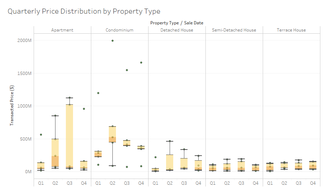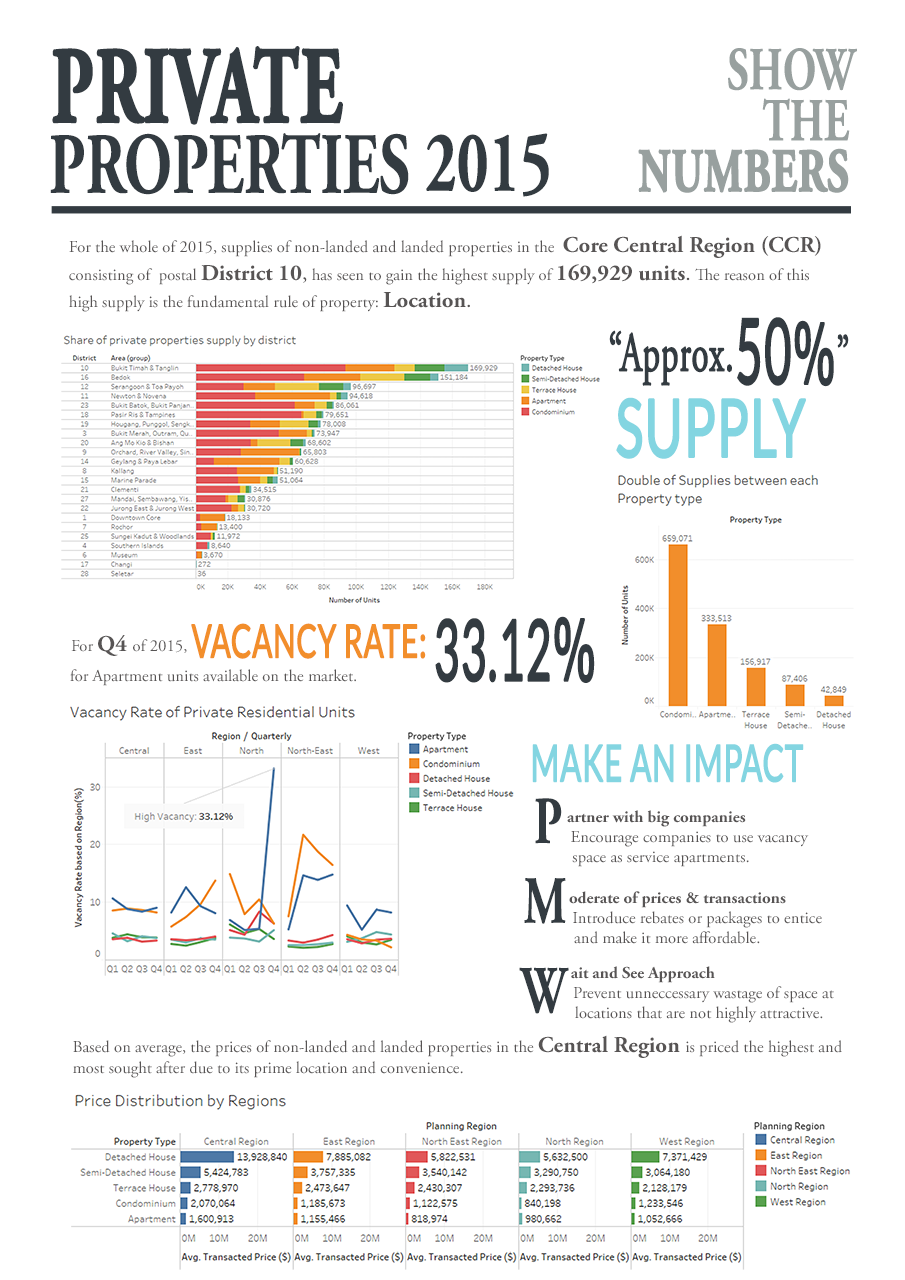IS428 2016-17 Term1 Assign1 Lim Kim Yong
Contents
Abstract
This project aims to help potential buyers and property developers to gain an upper-hand in deciding where and when an attractive “entry point” by region or “entry time” by different quarters of the year is. Through the data visualization, it will help users to clearly identify areas/patterns/ trends of the distribution prices and supplies of different private property types in Singapore. Finally, it will then provide policy recommendations based on our findings.
Problem and Motivation
Prices of private homes fell 3.7 percent for the whole of 2015, according to data released by the Urban Redevelopment Authority (URA). Despite the fact that prices had dropped, and every Singaporeans would want to own a private property, the vacancy rates of private properties are still remaining high. Private properties are seen to be a good investment for many Singaporeans; however, the prices of private properties can be ranged from moderate to super expensive based on the regions/areas in Singapore. Hence, only high-income individuals/Singaporeans can afford to purchase them.
Furthermore, with fewer jobs being created, there has been a relatively lesser influx of expatriates moving to Singapore, which has caused a fluctuation in demand and supply. Expatriates, who jobs have been affected, have also moved out of Singapore. This has led to an increase in supply of home units.
In order to prevent this situation from occurring, it would not be meaningful to price new units based on what developers think is profitable, but rather more on what is affordable to buyers to drive sales. Therefore, it is imperative to closely analyze the private properties regions and introduce new policies or improvements, so that it will be a win-win situation for the potential buyers, developers, and the government.
The analysis will identify:
- Supply of private property types across different regions and districts.
- Distribution of sales prices of private property types across different regions in Singapore based on different quarters in Year 2015.
This analysis hopes to target on regions and districts in Singapore that has the highest vacancy rates and for potential buyers to have an informed decision when purchasing of private property.
Approaches
It is important to have domain knowledge in order to understand the terminologies used in the datasets. This can be done through the use of internet to research on the definitions and also by reading through some available materials to have a better understanding of the land policies and challenges faced in the current private properties market in Singapore. Subsequently, I have downloaded the statistical report of URA-Property Market Information and extracted data from REALIS database which is purely focusing on the private residential properties. There are 3 different tabs that I had made used of when collecting data for my analysis. They are:
- Time Series – This provides me with a compiled statistics filtered by the different property type that contains data such as Vacancy Rate and Vacancy Stock through the different regions – Central, East, North-East, North, and West from different quarters of the year.
- Transactions – This provides information containing the transacted prices of various property type based on their regions, districts, unit price psf., sales dates, etc.
- Stock – This provides information regarding to the supply of units for each property type based on their regions, areas, and the different quarters of the year.
Initial Data Cleaning
Having all these massive amount of complex data, I begin to identify any connections/relevancies/entities between the data by using excel 2010. Certainly, there are some concerns for using the data straight in the raw form are:
- Removing redundant or irrelevant information and remove extra wordings that may cause Tableau to “misbehave” or show the error status.
- “Unfriendly” data arrangement that would cause error when raw data is imported straightly into Tableau.
Therefore, I cleaned up the data before I import them into Tableau to start generating charts or graphs for the purpose of data visualization.
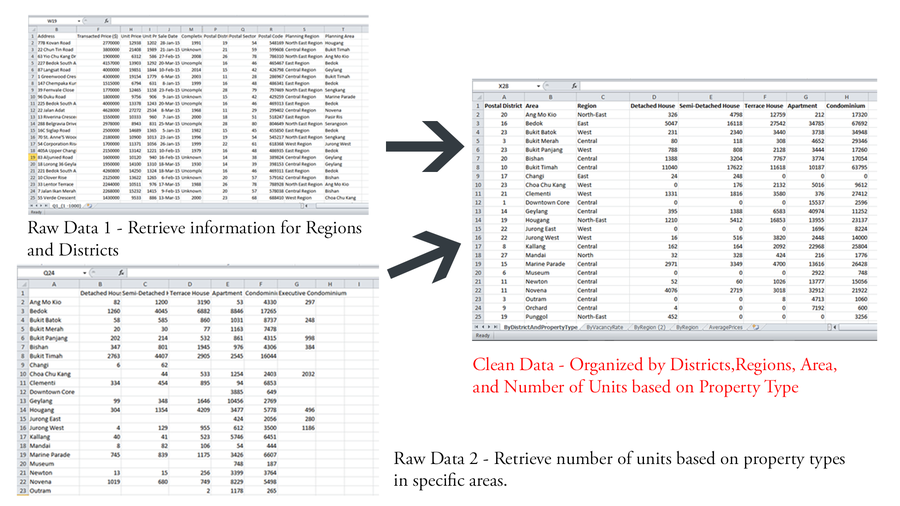
Visualization of Graph
Supply of Private Properties in Year 2015
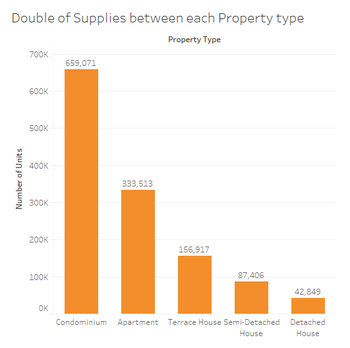
While analyzing the dataset from REALIS regarding the different private property types, the number of units, I noticed the supply of Condominiums scored the highest among the other properties that includes Non-Landed property (Apartment) and Landed property(Detached House, Terrace House and Semi-Detached House). Based on my analysis, Singapore is a small island; we could not afford to use large spaces to build landed properties. Therefore, it will be wiser for property developers to build and supply high-rise units like condominiums and apartments. Furthermore, developers can build more units in non-landed property as compare to landed property as they usually can build and produce more units for sale. As a result, there is a skyrocket of supply for non-landed property units compare to landed-property units.
Vacancy Rate based on Regions and Property Type
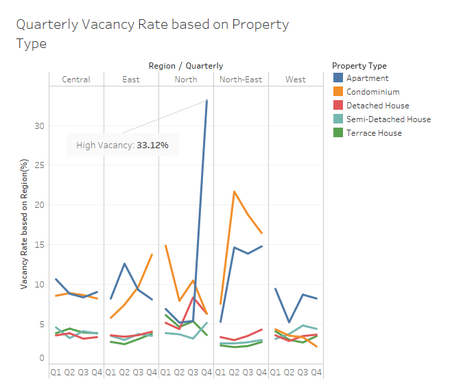
A Line graph is selected for representation because it will allow the reader to easily identify and compare the vacancy rates of different property type based on their regions and the different quarters in the year of 2015. Line graph is preferred over bars/circles because the graph tends to get messy and confusing as there are multiple occasions of overlapping of path. Therefore, by color-coding the lines the reader could easily identify the property types and see the pattern of growth in vacancy rate based on the region.
From the line graph, we observe that the property type of Apartment in the North region has the highest vacancy rate of 33.12%. This observation could be contributed by three reasons:
- The location in North region is not attractive and the price is still slightly expensive than other regions. The area is relatively far from the city, and transport can be challenging due to traffic.
- An apartment is usually smaller and has fewer facilities as compared to condominiums.
- A weak economy in 2015, with tighter foreign manpower policies imposed, and more units coming onto the market might be a factor to the rise of vacancy rate as well.
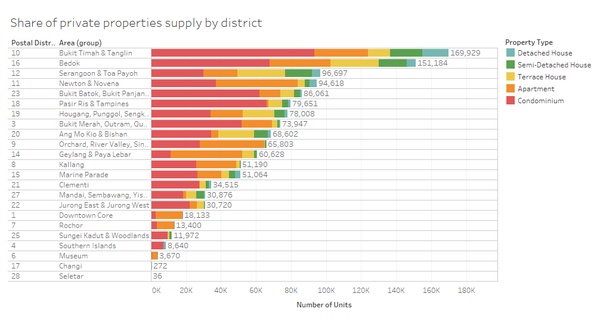
A stacked graph is selected for representation because it will allow the reader to easily find out which district has the most number of private residential units based on the total cumulative values across all the property types.
From the stacked graph, we observe that district 10 has the highest share of private properties supply of 169,929 units in the year 2015. This observation result comes as no surprise considering that district 10 is in the Core Central Region (CCR) stretching from Singapore’s Central Business District to Orchard Road, Cairnhill, Tanglin, River Valley, Newton and Bukit Timah. Due to its prime location and convenience, the residential developments in the CCR are priced the highest. Thus, developers will be very keen to supply units in that region so that they could reap high profits for themselves.
Price Distribution by Regions
A bar chart is selected for representation because it will help the reader to easily understand the situation quickly and see the skewed difference on each level. Color-codes will help the reader to identify which regions has the highest price distribution (measured by the average transacted price) based on the various property types.From the bar chart, we observed that all private properties in the Central Region have the highest average transacted price across all other regions. This observation result comes as no surprise considering that the Central Region is a prime location and convenience as it is fairly close to the city with excellent shopping venues and local food markets. Furthermore, prices for detached houses remain the highest price throughout all other regions. This might be due to the fact that Singapore is a small country with the scarcity of land. As a quote from Benjamin Graham, “Price is what you pay, and value is what you get”. The larger the space you own, the more expensive it will costs.
Tools Utilized
The following tools were used during the project:
- Microsoft Excel – Data cleaning and transformation so that it can be imported into Tableau for analysis
- Tableau 10.0 – Chart generation and visualization to perform analysis to find patterns
- Photoshop CS6 - Creation of infographic to present complex information quickly and clearly.
- Microsoft Word - Document findings and results
Infographic
Suggestions
Follow the "PMW" Approach
- "Wait and See Approach" to reduce the oversupply of private residential units. Governments and developers to slow down the supply of private properties to prevent unnecessary wastage of lands at locations that are not highly attractive.
- Moderate of prices and transaction. Introduce rebates or packages to attract make private properties more affordable for the buyers.
- Partner with big companies to reduce vacancy rates. Companies can use these empty spaces as service apartments for their employees or expatriates.
Conclusion
In the visualization graphs, we have shown that central region has the highest price and supply of private properties due to its prime location and convenience. Besides, the North region remains as the highest vacancy rates due to poor location.Therefore, the government and property developers should come up with attractive policies such as providing more infrastructures, affordable prices, or even having more shopping malls to attract home-buyers to stay in those less popular regions/areas. This would help to create an equal spread among all other regions and prevent overcrowding in the central region.

